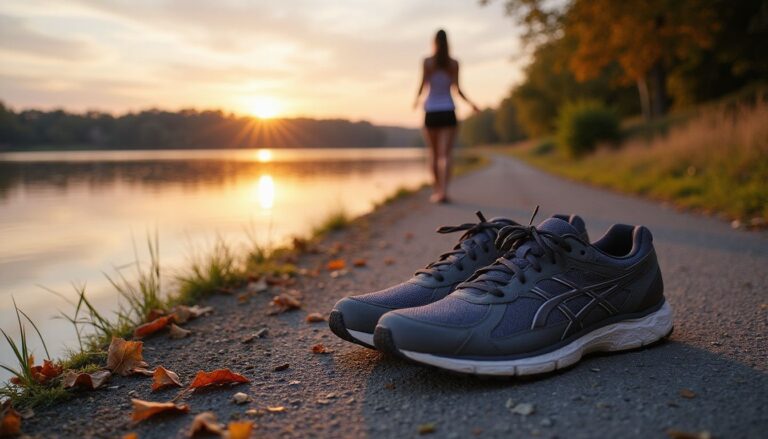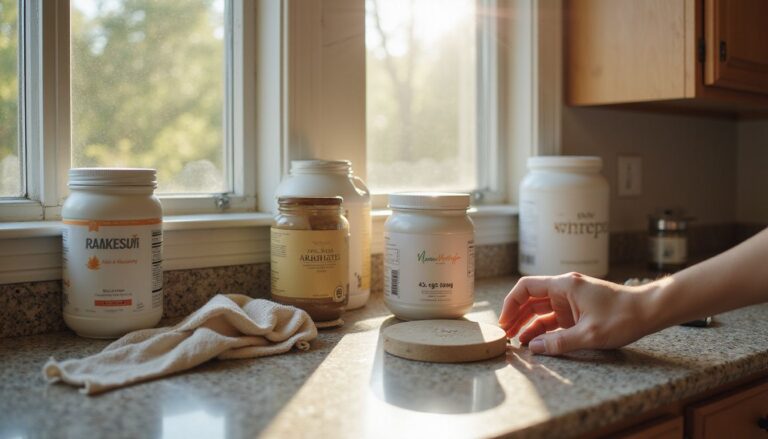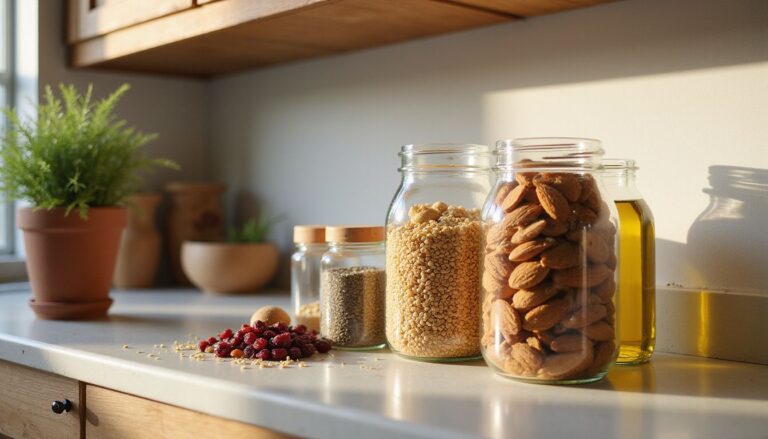7-Day Exercise For Weight Loss: Burn Fat, Lose Belly Fat, And Lose Weight With Full Body Workout
Our Nutrition Assistant AI Suite will transform your body. You will lose fat, get toned, and build muscle. Gain confidence and optimal health.
Trying to lose belly fat fast? A focused 7-day exercise plan can help. Pair full body workouts with a small calorie deficit to burn fat, build strength, and feel better.
This guide gives you a simple weekly schedule with squats, lunges, cardio, and core work. You also get clear tips for healthy eating, hydration, and tracking. Start your week of progress today.
Key Takeaways
- Mix full-body strength, cardio, and HIIT with a daily 500-calorie deficit to lose about one pound per week.
- Consistency wins. Aim for at least 30 minutes a day, five days a week, to support long-term weight loss.
- Muscle burns about 6 calories per pound per day at rest, while HIIT can raise post-workout calorie burn by up to 30 percent.
- Drink about half your body weight in ounces of water. Choose lean protein, high-fiber foods, and limit added sugar and ultra-processed foods.
- Track workouts and meals, set small goals, and include rest days to stay motivated and avoid burnout.
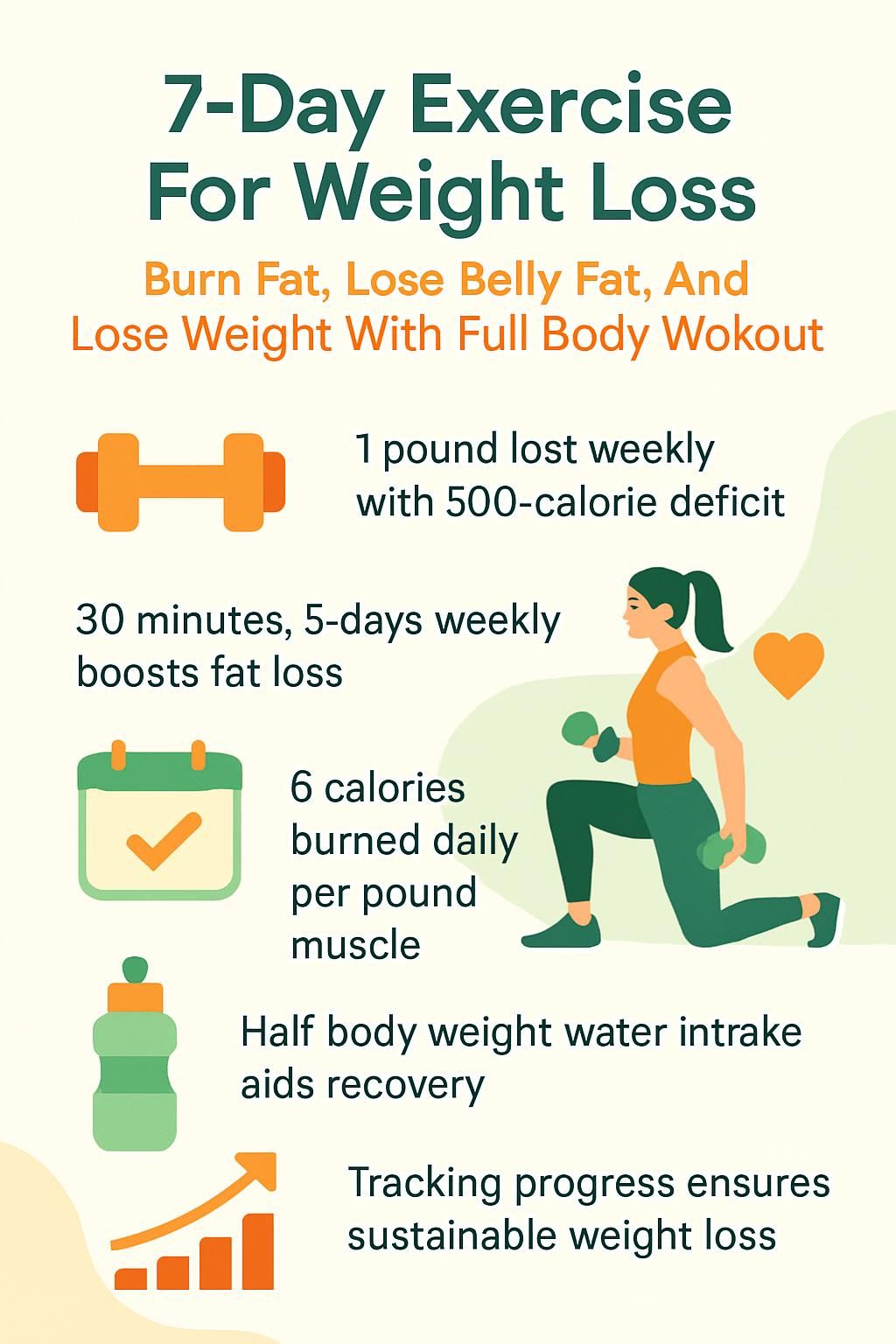
Why a 7-Day Workout Plan Works for Weight Loss
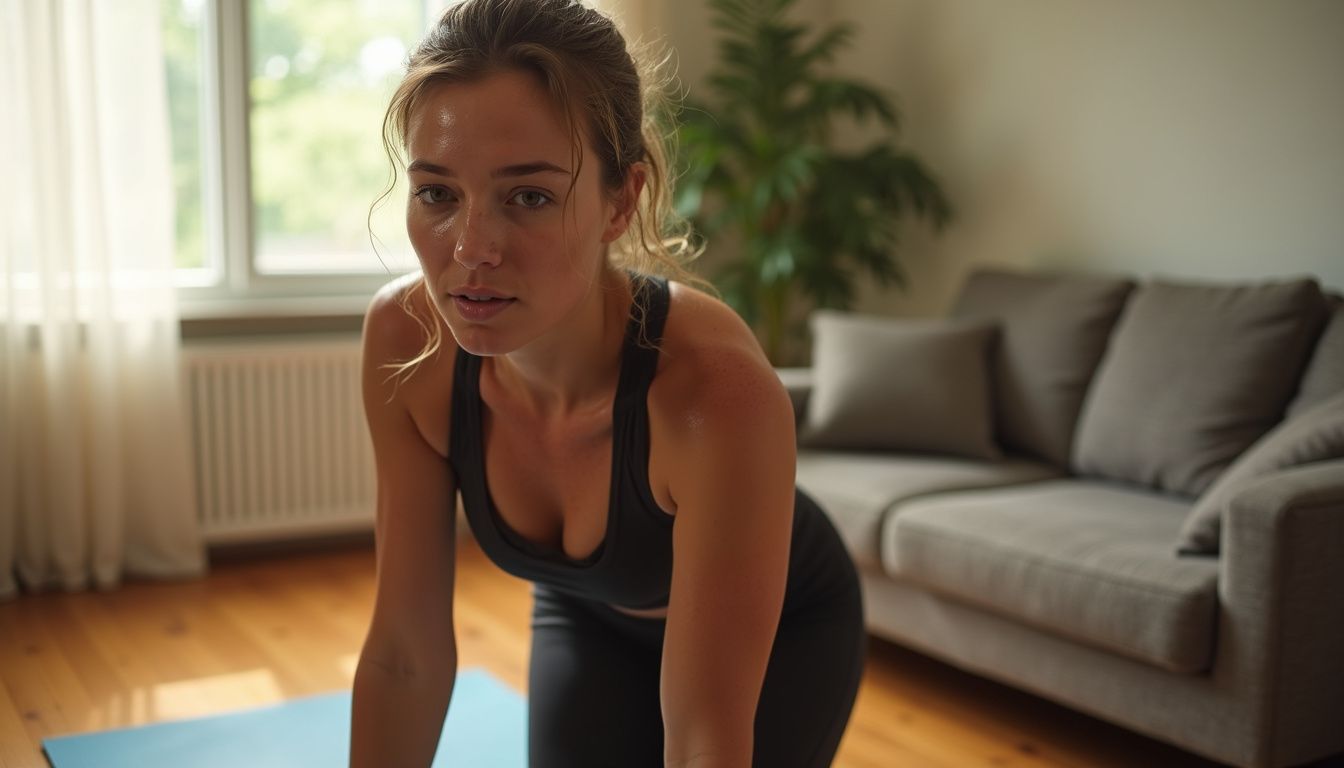
A short, structured plan helps you focus, build momentum, and see early wins. Short sessions, like a 7-minute circuit or a 30-minute walk, add up quickly over a week.
Why is consistency important for weight loss?
Sticking to a schedule raises your weekly calorie burn and lowers body fat over time. Routine also improves metabolism, which supports steady fat loss.
People who exercise at least 30 minutes a day, five days a week, reach their goals more often than those who skip days. J.R., who struggled with routine, saw faster progress after completing a daily 7-minute workout challenge on YouTube.
Regular practice makes tracking easier and keeps motivation high during your weight loss journey.
The key to long-term weight loss is not just working out hard, but working out consistently, says fitness coach Amanda R., who lost 25 lbs by sticking to a routine.
How does combining cardio and strength training help burn fat?
Cardio burns calories fast. Strength training builds muscle, which increases your resting calorie burn throughout the day. Fat tissue burns about 2 calories per pound per day at rest, while muscle burns about 6.
Blend steady-state cardio with HIIT and full-body strength work. This keeps your heart rate up and targets many muscles in one session. HIIT also triggers afterburn, called excess post-exercise oxygen consumption, which raises calorie burn for hours.
If you are a beginner, start easy. Add reps for endurance and add weight for strength as you improve. This strategy supports long-term results better than diet alone.
What role does a calorie deficit play in losing weight?
A calorie deficit means eating fewer calories than you use. Your body then taps stored fat for energy, which helps reduce body weight and belly fat.
Use a Basal Metabolic Rate, or BMR, calculator to estimate your needs. Aim for about a 500-calorie daily deficit for a pace of one pound per week. Many people, such as MD at 2,000 kcal per day, find portion control and food tracking helpful.
Choose lean protein and high-fiber foods. Limit added sugar and heavily processed items so your deficit works better with your workouts.
Key Considerations Before Starting
Check your current fitness level and your goals before you begin. Fuel, water, and sleep support recovery and performance. If you have a medical condition or past injury, talk with a healthcare professional first.
How do I assess my fitness level before starting?
Test simple moves before starting any full body workout. See how long you can jog or brisk walk without stopping. Count how many push-ups, sit-ups, or squats you can do in four minutes.
Pick weights that feel challenging but safe, about 60 percent of your best effort. Use simple home tools, such as a chair or bench, if you do not have gym access. Keep form clean, especially if you are overweight or just getting started.
“Start slow and let progress be your guide,” advises Russell, who shared his journey in a popular YouTube video.
Retest weekly so you can increase intensity as your strength and stamina grow. Next, set goals that fit your life.
How can I set realistic weight loss goals?
Begin with your BMR to estimate daily calories. Then target a 500-calorie daily deficit for steady loss. This pace often yields about one pound a week.
Track weekly and adjust based on data, not mood. MD went from 266 lbs to 235 lbs in five months, then set a goal of 225 lbs by the end of May. Build the workout habit first, then raise intensity and refine food choices.
Track both scale and non-scale wins, such as better endurance or rowing farther in four minutes. A supportive community can make progress easier.
Why is hydration and a balanced diet essential for workouts?
Water helps muscles work better and recover faster. A common target is half your body weight in ounces daily. For example, if you weigh 200 pounds, aim for about 100 ounces, most of it earlier in the day.
Balanced meals with lean protein and fiber fuel exercise and support fat loss. Limit added sugars and processed foods. Many lifters use protein or creatine to aid recovery, though whole foods should lead the way.
Next, use the 7-day plan below to build steady progress.
The 7-Day Weight Loss Workout Plan
This 7-day schedule shows you what to do each day to burn fat, build muscle, and stay consistent. Many people follow similar plans using home gear or simple routines they find on YouTube.
What does Day 1 full-body strength and cardio include?
- Warm up for 5 to 10 minutes with dynamic moves to prepare joints and muscles.
- Use barbells or dumbbells for heavier sets with lower reps. Choose safe, challenging loads.
- Include dumbbell pullover, dumbbell bench press, and Arnold press for the upper body.
- Do 20 to 30 minutes of cardio after strength work or later in the day. Brisk walking or cycling both work well.
- Add one core move, such as planks or crunches, to brace your midsection.
- Finish with light stretching for major muscle groups to improve mobility.
- Hydrate before, during, and after the workout. Drink 16 to 24 ounces after training.
- Use recovery tools like easy stretching, foam rolling, and a protein-rich snack.
- Record your exercises and how you felt. Early wins can boost confidence for Day 2.
What low-impact cardio and core exercises are best for Day 2?
- Walk at a moderate pace for 20 to 30 minutes. It burns calories with little joint stress.
- Ride a stationary bike at a gentle pace. Adjust resistance to your fitness level.
- Try brisk walking indoors or outdoors. Add arm swings for extra movement.
- Hold planks for 20 to 40 seconds, repeating three to four times.
- Use seated knee lifts for controlled core work. Aim for 10 to 15 reps per set.
- Perform dead bugs for core stability. Do 10 to 12 reps per side with a flat back.
- Stretch for 5 to 7 minutes after cardio to ease tight muscles.
- Keep drinking water before, during, and after your session.
- Increase time or intensity slowly as fitness improves.
- Many people, like Sophia, mix in longboarding for fun movement that keeps them active all week.
How does High-Intensity Interval Training (HIIT) work on Day 3?
- Alternate 30 seconds of hard effort, such as sprints or jumping jacks, with 30 to 60 seconds of easy movement.
- Keep sessions between 20 and 30 minutes. Longer sessions can reduce quality.
- Use moves like burpees, mountain climbers, squat jumps, or bicycle crunches.
- Research shows HIIT can burn up to 25 to 30 percent more calories than steady cardio in the same time.
- You only need a floor mat and determination. No fancy gear required.
- Start at moderate intensity, then increase effort as your fitness grows.
- HIIT helps reduce belly fat while improving heart and muscle fitness.
- Do it at home or in a gym. Flexibility makes this routine easy to stick with.
Next, use Day 4 to recover so you can train hard again.
What are good active recovery activities for Day 4?
- Stretch for at least ten minutes with dynamic or static moves to improve flexibility.
- Walk gently for fifteen to twenty minutes to boost blood flow without extra stress.
- Try a yoga flow with deep breathing and long stretches for better mobility.
- Foam roll major muscle groups, such as quads and hamstrings, to reduce tight spots.
- Use a lacrosse ball or massage tool on sore areas to release knots.
- Drink water through the day to support muscle function.
- Target eight hours of sleep, which supports recovery and fat loss.
- Meditate for five minutes to ease stress and improve focus.
- Wear comfortable clothes and shoes so your body can relax and heal.
After a tough HIIT day, I felt tight legs, but yoga and foam rolling sped my recovery so the next session felt strong.
Which exercises target lower body strength on Day 5?
- Start with goblet squats using a dumbbell or kettlebell. Try 3 sets of 15 to 20 reps.
- Do hip thrusts to train glutes and hamstrings. Use a bench or sturdy chair.
- Perform walking lunges for at least 20 steps per set for 3 to 4 sets.
- Add one core move, such as bicycle crunches or planks, to support your spine.
- Hydrate after training. Lower body work can increase sweat and fluid loss.
- Keep form tight and consistent to prevent injury.
- Use machines or bodyweight alternatives if training at home.
The first time I used only bodyweight and a heavy book for squats, I felt sore but proud. The session pushed both endurance and strength.
What core and upper body exercises should I do on Day 6?
- Start with bent-over dumbbell rows for upper back and biceps. Use 12 to 15 reps.
- Perform incline dumbbell bench presses for chest, shoulders, and triceps. Do 12 to 15 reps.
- Hold a plank for 30 to 60 seconds to brace your core.
- Complete ab crunches for 15 to 20 reps to strengthen your midsection.
- Add resistance band chest presses to vary the stimulus.
- Do shoulder presses with dumbbells for 12 to 15 controlled reps.
- Stretch your upper body with arm circles, chest stretches, and easy twists.
What are effective rest or light activities for Day 7?
- Walk at a slow pace for 20 to 30 minutes to increase circulation.
- Use yoga poses like child’s pose or cat-cow to release tension.
- Meditate for 10 to 15 minutes to lower stress and reset your mind.
- Stretch each major muscle group for 20 to 30 seconds.
- Drink water throughout the day to support recovery.
- Practice deep breathing to relax your body and calm your nervous system.
- Update your fitness journal or app to review the week.
These actions set you up to start the next week with better recovery and focus.
Best Exercises for Weight Loss
Some activities burn more calories and help reduce belly fat faster. Use these options to boost results from your full body workouts.
How does walking or brisk walking aid weight loss?
Walking raises daily calorie burn and supports a steady deficit. It is simple, joint friendly, and needs no gear.
Start with 20 to 30 minutes. Increase pace or add short brisk intervals as you improve. On recovery days, walking keeps you moving without extra strain.
Sophia switched to longboarding for variety. Finding a pastime you enjoy makes consistency much easier.
Why is jumping rope effective for burning fat?
Jumping rope drives your heart rate up and works many muscles. That means higher energy use and fat burn.
Harvard data estimates a 155-pound person burns about 372 calories in 30 minutes of rope jumping. You need very little space, which helps at home.
Use it for steady cardio or add short bursts to a HIIT routine. In my own training, ten focused minutes of rope felt tough and trimmed fat faster than an easy jog.
What benefits does cycling provide for weight loss?
Cycling is low impact and easy to maintain. Ride 20 to 30 minutes indoors or outside for steady calorie burn.
Regular rides build cardiovascular fitness and support belly fat loss when paired with a balanced diet. Switching between cycling and walking can prevent boredom and keep motivation high.
How does swimming contribute to fat burning?
Swimming trains the whole body and burns calories quickly. A 155-pound person may burn about 216 calories in 30 minutes at a moderate pace, based on Harvard Medical School estimates.
Water provides natural resistance, so arms, legs, and core work together. It is gentle on joints, and intensity is easy to adjust.
With consistent pool sessions, endurance rises and belly fat can drop. Weekly swims helped me trim weight while keeping my joints comfortable.
What strength training exercises help with weight loss?
Strength work raises your basal metabolic rate. Include dumbbell pullovers, dumbbell bench presses, and Arnold presses for the upper body.
Use goblet squats, hip thrusts, and walking lunges for the lower body. Mix heavier, low-rep days with higher-rep endurance sessions across the week.
Focus on form to prevent injury. Combining cardio with full-body strength training improves fat loss more than cardio alone, according to research from the National Institutes of Health [1].
As you get consistent, increase resistance or volume to keep progressing.
[1] National Institutes of Health: Effects of Strength Training on Weight Loss
How does High-Intensity Interval Training (HIIT) boost fat burn?
HIIT alternates short bursts of hard effort with brief rest. Sessions can be finished in 20 to 30 minutes, which fits busy days.
The afterburn effect increases calorie use for hours after training. Studies show HIIT may burn up to 30 percent more calories than steady cardio in the same time.
On Day 3 of this plan, I usually feel both tired and energized. That mix keeps me engaged and more likely to show up tomorrow.
How can yoga or Pilates improve flexibility and core strength?
Yoga and Pilates strengthen your core, the muscles of your abs, hips, lower back, and pelvis. They also increase flexibility and reduce injury risk.
A mat is enough to begin. These methods support posture, balance, and stress relief through breathing and controlled movement.
Use them on light days to loosen tight muscles and speed recovery so you stick with your plan.
Nutrition Tips to Maximize Results
Smart food choices accelerate fat loss and fuel quality workouts. Aim for protein at each meal, fiber-rich carbs, and enough water daily.
What lean proteins and high-fiber foods should I eat?
- Skinless chicken breast, about 26 grams of protein per 3 ounces with very little fat.
- Turkey breast, choose 93 percent lean or higher for fewer calories.
- Fish like salmon or tuna, high-quality protein plus omega-3 fats. Salmon has about 22 grams per 3 ounces.
- Greek yogurt, about 15 grams of protein per 6 ounces. Pick plain, low-fat options.
- Protein supplements, such as whey or plant-based powders, can help on busy days.
- Beans and lentils, protein plus fiber. One cup of cooked lentils has about 18 grams of protein and 15 grams of fiber.
- Eggs, around 6 grams of protein and 70 calories per egg.
- Oats, about 4 grams of fiber per half cup dry.
- Leafy greens, like spinach or kale, full of vitamins with very few calories.
- Berries, such as raspberries, with fiber and antioxidants. One cup has about 8 grams of fiber.
- Whole grains, including brown rice or quinoa, to steady blood sugar and provide lasting energy.
Why should I limit processed foods and added sugar?
- Ultra-processed foods often pack excess calories and unhealthy fats, which can raise belly fat.
- Added sugar causes energy spikes and crashes, which can lead to cravings and overeating.
- Eating fewer processed items reduces hidden sugars and helps build better habits.
- Stable blood sugar supports steady energy for your full body workouts.
- Studies in 2022 linked high processed food intake to greater obesity risk and weight regain.
- Lowering added sugar reduces risk for diabetes and heart disease.
- Whole foods make it easier to feel full on fewer calories.
- Keeping these limits supports a calorie deficit without feeling deprived.
How can I control portion sizes and avoid late-night snacking?
- Use smaller plates and bowls. People often eat less when portions look larger.
- Plan meals and snacks in advance to avoid hunger-driven choices at night.
- Track food in a diary or app to find patterns and triggers.
- Serve food on plates, not from bags or containers, to control portions.
- Eat slowly to notice fullness cues. This simple step can cut calories at meals.
- Keep a steady meal schedule to support appetite and blood sugar control.
- Choose high-fiber foods to stay full longer and reduce cravings.
- Avoid screens while eating, since distraction can lead to overeating.
- Set a kitchen closing time to curb late-night grazing.
- Keep an eye on portions. One reader, MD, credits portion control for long-term success.
- Limit processed foods and added sugars that drive cravings, especially at night.
Benefits of This 7-Day Workout Plan
With a clear schedule and daily action, you can see early progress in fat loss and fitness. The plan helps reduce belly fat and supports steady weight management.
How does this plan accelerate fat burning?
The mix of HIIT, steady cardio, and strength raises total weekly calorie burn. Each session targets multiple muscles, which increases energy use during and after training.
Cardio keeps your heart rate up for 20 to 30 minutes. Strength work with heavier loads and higher reps boosts metabolism and post-workout burn. Core training shows up through the week for a stronger midsection.
From experience, combining these styles leads to more energy and visible changes sooner.
What cardiovascular health improvements can I expect?
Regular cardio makes your heart stronger and raises endurance. Moderate-intensity sessions, at least 150 minutes per week, can lower heart disease risk, based on public health guidance.
HIIT improves fitness with short, hard bouts and brief rests. Steady-state cardio builds long-term aerobic capacity. Switching between them prevents plateaus and keeps training fresh.
People often notice easier daily walks and a lower resting heart rate after a week of consistent activity.
How does it increase strength and endurance?
Using both heavy and lighter weights builds strength and stamina. Lower body days train legs and glutes. Upper body days target arms, back, chest, and shoulders.
Progress matters. Increase weight or reps over time to signal growth. Higher-rep sets build muscular endurance so you can work longer without fatiguing.
Working all major muscles across the week lays a base for harder training later.
How does this plan help reduce belly fat?
Daily core work strengthens your midsection. Cardio plus strength increases total calorie burn, which helps reduce overall fat, including the waistline.
Fat loss still requires a calorie deficit. Track your intake and measure your waist to see steady changes. Many people find belly fat is stubborn, but consistent training and balanced meals make a difference.
Tips for Staying Consistent and Motivated
Consistency builds habits that last. Use simple systems to track progress and keep your drive high through the 7 days and beyond.
How can I effectively track my progress?
- Log every workout in a journal or app, including exercises, sets, reps, and loads.
- Take weekly photos and measure waist, hips, and chest to spot changes beyond the scale.
- Weigh in at the same time each week and track energy and stamina wins.
- Do weekly or monthly check-ins to review goals and results.
- Track meals in a food app to support your calorie deficit.
- Measure cardio gains, such as distance covered in a set time.
- Share updates with a buddy or group for accountability and support.
- Reflect on what worked and what needs a tweak.
- Celebrate small wins, like a new rep record or longer plank time.
Why should I work out with a buddy or join a group?
- Partners raise motivation and accountability, which lowers the chance of skipping.
- Groups offer social support. People stick to routines more when encouraged by others.
- Shared progress inspires everyone trying to burn calories or lose belly fat.
- Community support reduces isolation for those new to fitness classes.
- Accountability partners improve consistency because someone is expecting you.
- Social time makes hard workouts feel easier.
- Research in the Journal of Social Sciences suggests people mirror the exercise habits of their peers, which can lift compliance.
Working with a partner pushed me through tough days. Friendly encouragement made the 7-day challenge more enjoyable.
How can celebrating small achievements keep me motivated?
Small wins build confidence. Adding five pounds to a lift or running one extra minute shows progress you can feel.
Tracking and rewarding these gains supports long-term success. Share milestones with friends or groups to boost morale and keep momentum.
Common Mistakes to Avoid
Simple errors can slow results. Avoid these setbacks so your weekly plan keeps working for you.
Why is skipping rest days harmful?
Muscles need time to repair after hard sessions. Without rest, you risk overtraining, injury, fatigue, and higher stress hormones like cortisol, which can fight fat loss.
Rest days protect your motivation and immune system. Light stretching, quality sleep, and short meditation help you recover and perform better next time.
How can overtraining or pushing too hard affect results?
Going too hard can stall progress and raise injury risk. Tiredness, lingering soreness, and low drive are warning signs.
Beginners improve most on modest volume with proper rest. Adjust intensity based on how you feel, and your consistency will improve.
What are the risks of ignoring proper nutrition?
Skipping good nutrition can cancel out workout gains. It becomes hard to stay in a calorie deficit, and energy crashes can follow.
Balanced meals, smart portions, and steady hydration support recovery and performance. Supplements can help, but whole foods should lead your plan.
People who combine training with healthy eating achieve better weight control over time.
Conclusion
A 7-day exercise plan gives you structure to burn fat and lose weight. Combine cardio, strength, and core work with a small calorie deficit. Stay consistent, hydrate well, and choose whole foods.
Protect your progress with rest days and simple tracking. With steady effort, you will build fitness, lift energy, and reduce belly fat in a sustainable way.
FAQs
1. What is a 7-day exercise plan for weight loss and how does it help burn fat?
A 7-day exercise plan for weight loss uses full body workouts to increase calorie use, boost metabolism, and target belly fat. Research shows that combining aerobic activities with resistance training can reduce total body fat and abdominal fat more effectively than either alone (Harvard Health Publishing, 2022). This approach helps the body use stored energy from fat while preserving muscle.
2. Can I lose belly fat in one week with this workout routine?
Losing significant belly fat in one week is unlikely; however, consistent full body workouts can start the process of reducing abdominal fat over time. Studies suggest that regular physical activity paired with healthy eating leads to gradual but lasting changes in waist size and overall health (CDC, 2023).
3. What types of exercises are included in a full body workout for weight loss?
Full body workouts often include squats, lunges, push-ups, planks, jumping jacks, burpees, and brisk walking or cycling. These movements engage multiple large muscle groups at once which increases energy expenditure during each session.
4. How many calories can I expect to burn daily on a 7-day program?
Calorie burn depends on age, gender identity category such as male or female assignment at birth as well as current fitness level and intensity of effort during sessions. On average moderate-intensity full-body routines may help an adult use between 200 to 400 calories per hour (American Council on Exercise). Tracking progress using wearable devices or apps provides personalized feedback.
Summary: A structured seven-day exercise schedule focuses on whole-body movement patterns proven by research to support steady weight reduction including lower abdominal circumference when combined with balanced nutrition choices over time rather than quick fixes or extreme restrictions.



